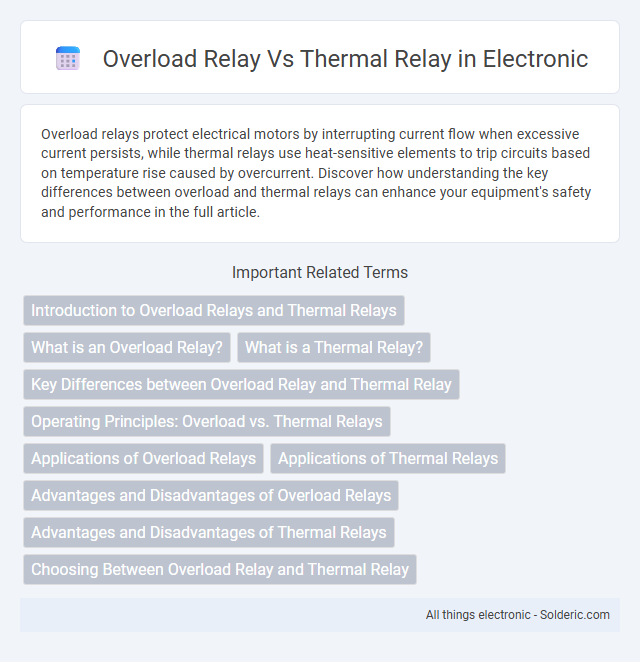Overload relays protect electrical motors by interrupting current flow when excessive current persists, while thermal relays use heat-sensitive elements to trip circuits based on temperature rise caused by overcurrent. Discover how understanding the key differences between overload and thermal relays can enhance your equipment's safety and performance in the full article.
Comparison Table
| Feature | Overload Relay | Thermal Relay |
|---|---|---|
| Function | Protects electric motors from overload by detecting excess current | Protects circuits by detecting excessive heat caused by overcurrent |
| Operating Principle | Electromagnetic or bimetallic element senses current overload | Bimetallic strip senses temperature rise to trip the circuit |
| Application | Motor protection in industrial and commercial equipment | General circuit protection against overheating |
| Response Time | Adjustable time delay to avoid nuisance tripping | Slower response based on temperature rise |
| Reset Mechanism | Manual or automatic reset available | Usually manual reset required |
| Installation | Mounted as part of motor starter or separate unit | Installed inline with circuit wiring |
| Typical Use | Electric motor overload protection | Overheating protection for wiring and devices |
Introduction to Overload Relays and Thermal Relays
Overload relays and thermal relays are critical protective devices used in electrical circuits to prevent motor damage caused by excessive current. Overload relays detect prolonged overcurrent conditions by monitoring the current flow and interrupting the circuit when it exceeds preset limits, while thermal relays use a bimetallic strip that bends with heat generated from the current to trigger disconnection. Both devices enhance motor safety by preventing overheating and potential electrical failures in industrial and commercial applications.
What is an Overload Relay?
An overload relay is an electrical protection device designed to prevent motors from overheating due to excessive current flow over a prolonged period, ensuring the motor's safe operation. It detects current levels above the motor's rated capacity and trips the circuit to avoid damage caused by thermal stress. Common types include thermal overload relays and electronic overload relays, each providing reliable motor protection based on temperature or current sensing.
What is a Thermal Relay?
A thermal relay is a protective device designed to safeguard electric motors from overheating due to prolonged overload conditions by detecting excessive current using a bimetallic strip that bends when heated. Unlike an overload relay, which may also include magnetic protection, the thermal relay specifically relies on temperature rise caused by electrical current to trigger a disconnection, preventing motor damage. It is widely used in motor control circuits to ensure operational safety and prolong equipment lifespan.
Key Differences between Overload Relay and Thermal Relay
Overload relays protect electric motors by detecting excessive current flow due to mechanical overload or stalled conditions, whereas thermal relays specifically respond to temperature rise caused by prolonged overcurrent. The primary difference lies in their sensing mechanisms: overload relays often use electromagnetic or bimetallic components, while thermal relays rely on heat-sensitive elements to interrupt the circuit. Understanding these distinctions helps you select the appropriate device for precise motor protection and circuit safety.
Operating Principles: Overload vs. Thermal Relays
Overload relays operate by detecting excessive current flow through a heating element that mimics the motor's current, triggering a trip mechanism when the temperature exceeds a set threshold. Thermal relays specifically rely on the expansion of a bimetallic strip heated by the current to break the circuit during overcurrent conditions. Understanding the distinctions in operating principles helps you select the appropriate relay for protecting electrical motors from overheating and damage.
Applications of Overload Relays
Overload relays are primarily used in motor protection circuits to prevent damage from excessive current caused by motor stalls or mechanical overloads. These devices are essential in industrial applications such as conveyor systems, pumps, and compressors where continuous motor operation must be safeguarded against overheating. Their role in ensuring operational safety and extending motor lifespan makes them indispensable in manufacturing and automation environments.
Applications of Thermal Relays
Thermal relays are widely used in motor protection circuits to prevent damage caused by prolonged overloads by detecting excessive current through heat-sensitive elements. Your industrial machinery benefits from thermal relays because they reliably protect motors from overheating, ensuring operational safety and longevity. These relays are essential in applications like pumps, fans, compressors, and conveyors where consistent thermal monitoring is critical.
Advantages and Disadvantages of Overload Relays
Overload relays protect electric motors by detecting excessive current and preventing damage from overheating, offering reliable motor protection with simple construction and cost-effectiveness. However, they may have slower response times compared to thermal relays and require periodic calibration to maintain accuracy. Your choice depends on the specific application needs, balancing durability against sensitivity and maintenance requirements.
Advantages and Disadvantages of Thermal Relays
Thermal relays offer the advantage of simple design and cost-effectiveness, making them suitable for protecting motors against overload by accurately detecting temperature rise due to current flow. Their drawback lies in slower response times compared to electronic overload relays, which can lead to delayed motor protection under rapid overload conditions. You should consider thermal relays when affordability and reliable thermal protection outweigh the need for fast trip characteristics.
Choosing Between Overload Relay and Thermal Relay
Choosing between an overload relay and a thermal relay depends on the specific protection requirements of your electrical system. Overload relays provide precise current monitoring and adjustable settings to protect motors from damage due to prolonged overcurrent conditions. Thermal relays, on the other hand, rely on temperature-sensitive elements to trip circuits when excess heat is detected, making them ideal for simpler or cost-effective motor protection.
Overload relay vs thermal relay Infographic

 solderic.com
solderic.com